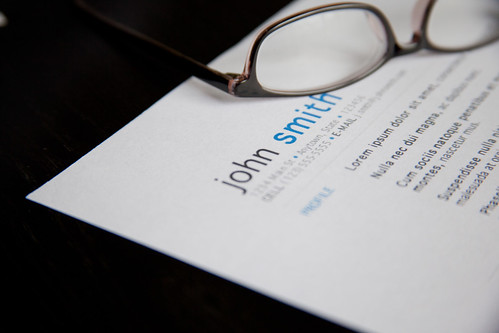Resume Like a Man
Want a STEM Job? Write Your Resume Like a Man
Beth Taylor, a.k.a. UnderCover Waitress, PayScale
Apr 29, 2015
Women continue to chip away at the glass ceiling, slowly but surely, but gender bias can hold them back in lucrative fields like STEM. Some analyses of men's and women's resumes offer clues for women to help themselves break into that science-based dream job. Consider writing your resume "like a man."

(Photo Credit: flazingo_photos/Flickr)
The Gender Gap in STEM Jobs
There is no doubt that the gender gap exists, and STEM fields are biased against women. Social psychologist Corinne Moss-Racusin's research includes an experiment that asked scientists (both male and female) to evaluate identical resumes. The only difference was the name on the top of the resume: one said "John" and the other said "Jennifer."
John was more likely to be hired. Those that were willing to hire Jennifer offered her, on average, $4,000 less per year (13 percent) than John. They were also less willing to take the time to mentor Jennifer. It is interesting to note that female scientists also favored John, underlining the pervasive gender bias in STEM professions today.
Including diversity workshops and courses in the required continuing education of professionals may be one good way to fight this gender bias in the long run. But if you are a woman looking for a job today, there are things you can do to help yourself, including rewriting your resume.
Male vs. Female Resumes
While the above-referenced study did find that men were preferred when the resumes were identical, it is also true that women and men seem to craft their resumes in different ways. In many professions, the masculine style of resume is preferred.
Kieran Snyder, writing for Fortune, analyzed 1,100 technology resumes, including 512 from men and 588 from women. She found both similarities and consistent differences in the way men and women with similar education, experience, and qualifications represent themselves.
· Length Matters. Women and men may be describing the same job, but woman use more words. Men are more likely to keep their resumes at one page because they are less wordy.
· Present Facts. Women are more likely to tell a story with complete sentences. Men, on the other hand, create bulleted lists of achievements. Men's resumes in Snyder's analysis provided more detail with less words and less distraction.
· Verb Statements. Men are more likely to use strong verb statements that summarize their prior jobs. Women seem to describe their former roles with passive statements and with extraneous detail. For example, a man might say, "Researched, designed, and implemented new customer service software." Snyder gives the following example of a women's typical resume:
Highlights on the delivery team included working on a new automatic tracking platform, partnering with product management and marketing, and hiring four new team members.
When you craft your next resume, get to the point quickly. Highlight what you accomplished in active, verb-based sentences. Then, move on to the next position on your resume. You are more likely to get the interview, and when you do, you can discuss what you can do for the company in detail with the hiring manager.